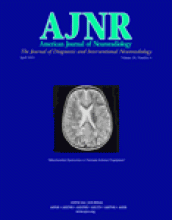Abstract
BACKGROUND AND PURPOSE: The endovascular occlusion of aneurysms with unfavorable configurations such as a broad neck and an important branch from the fundus remains a technical challenge. The purpose of this study was to evaluate the radiologic and clinical results of complicated aneurysm treatment by using two microcatheters.
METHODS: Twenty-five aneurysms in 25 patients were treated by using two microcatheters, from August 2001 to February 2004. Fourteen patients presented with a subarachnoid hemorrhage (SAH) and 11 had unruptured aneurysms. The aneurysms were of the basilar top (7), middle cerebral artery bifurcation (4), posterior communicating artery (4), anterior communicating artery (3), superior cerebellar artery (2), ophthalmic artery (2), and one aneurysm of each of cavernous internal carotid artery (ICA), dorsal ICA, and midbasilar artery. In 16 aneurysms (64%), the width of the aneurysm was the same or longer than the height. In 19 (76%), important branches arose from the aneurysm base, and some were even incorporated with the aneurysm fundus. The mean dome (height)-to-neck ratio was 1.23 ± 0.37 (range, 0.65–2.33), and this was greater than or equal to 1.0 in 19 aneurysms (76%).
RESULTS: All aneurysms were successfully embolized. Immediate postembolization angiography showed no residual contrast filling in eight aneurysms (32%), and some residual contrast filling in 16. The aneurysm remnants, however, were intentionally left to preserve important branches in 12 of the 16 aneurysms with incomplete occlusion. Two complications occurred, including one thromboembolic and one coil protrusion, but they were successfully resolved and produced no clinical symptoms. All patients except one showed excellent clinical outcomes. One patient revealed moderate cognitive dysfunction. During the follow-up period, no new bleeding occurred.
CONCLUSION: Our experience with 25 cerebral aneurysm patients shows that the technique of using two microcatheters is feasible and safe for coil embolization of aneurysms with unfavorable configurations. Although the lack of angiographic follow-up prevents us from drawing conclusions about its effectiveness as compared with other techniques such as stent placement and balloon-neck protection, we believe that this technique offers a reliable alternative for endovascular therapy of complicated aneurysms.
- American Society of Neuroradiology












